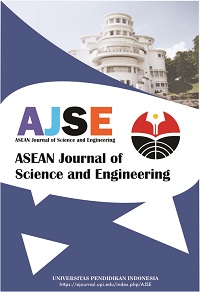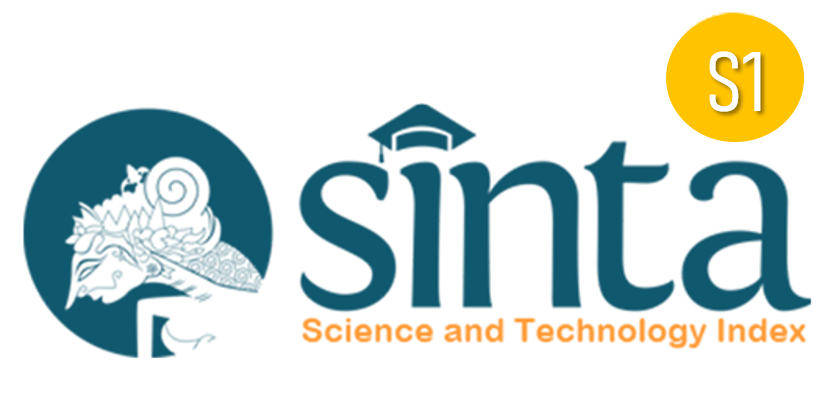Suppression of the Cassava Mealybug Populations, Phenacoccus manihoti (Hemiptera: Pseudococcidae) By Natural Enemies
Abstract
The most dominant mealybug species found on cassava is Phenacoccus manihoti. Parasitoid Anagyrus lopezi is a biological agent of P. manihoti in many countries. Monitoring the incidence and population of mealybug and the percentage of parasitization were done, as well as the population of ants and predator insects for 12 consecutive months. The highest incidence and attack rate of mealybugs were 26 and 64%, respectively, during the dry season. A. lopezi was able to suppress the population of P. manihoti between 2-17 individuals per plant with a parasitization rate varied from 12 to 46%. Our study showed that the parasitization rate of A. lopezi increased significantly with the increase in mealybug density. Predators P. ramburi and C. montrouzieri were found in low populations and have not had a significant impact on the mealybug population. Our study demonstrated the important role of natural enemies in suppressing the mealybug population on cassava
Keywords
Full Text:
PDFReferences
Al Husaeni, D.F., and Nandiyanto, A.B.D. (2022). Bibliometric using VOSviewer with publish or perish (using google scholar data): From step-by-step processing for users to the practical examples in the analysis of digital learning articles in pre and post covid-19 pandemic. ASEAN Journal of Science and Engineering, 2(1), 19-46.
Carrieri, M., Albieri, A., Angelini, P., Soracase, M., Dottori, M., Antolini, G., and Bellini, R. (2023). Effects of the weather on the seasonal popultion trend of Aedes albopictus (Diptera: Culicidae) in northern Italy. Insects, 14(11), 879.
Cudjoe, A. R., Neuenschwander, P., and Copland, M. J. W. (1993). Interference by ants in biological control of the cassava mealybug Phenacoccus manihoti (Hemiptera: Pseudococcidae) in Ghana. Bulletin of Entomological Research, 83(1), 15-22.
Dewi, S., Watson, G. W., Mohamad, R., Hanifah, Y. M., and Idris, A. B. (2015). First record of cassava mealybug, Phenacoccus manihoti (Hemiptera: Pseudococcidae), in Malaysia. Zootaxa, 3957(2), 235-238.
Fanani, M. Z., Rauf, A., Maryana, N., Nurmansyah, A., and Hindayana, D. (2019). Geographic distribution of the invasive mealybug Phenacoccus manihoti and its introduced parasitoid Anagyrus lopezi in parts of Indonesia. Biodiversitas Journal of Biological Diversity, 20(12), 3751-3757.
Fanani, M. Z., Rauf, A., Maryana, N., Nurmansyah, A., and Hindayana, D. (2020a). Parasitism of cassava mealybug by Anagyrus lopezi: Effects of varying host and parasitoid densities. Biodiversitas Journal of Biological Diversity, 21(10), 2085-4722.
Fanani, M. Z., Rauf, A., Maryana, N., Nurmansyah, A., and Hindayana, D. (2020b). Parasitism disruption by ants of Anagyrus lopezi (Hymenoptera: Encyrtidae), parasitoid of cassava mealybug. Biodiversitas Journal of Biological Diversity, 21(6), 2337-2343.
Fanani, M. Z., Rauf, A., Maryana, N., Nurmansyah, A., and Hindayana, D. (2024). Dinamika populasi kutu putih Paracoccus marginatus Williams and Granara de Willink (Hemiptera: Pseudococcidae) dan musuh alaminya pada tanaman singkong. Agronida Journal/Jurnal Agronida, 10(1), 27-38.
Fanani, M. Z., Rauf, A., Maryana, N., Nurmansyah, A., Hindayana, D., and Rochman, N. (2023). Functional response of endoparasitic wasp, Anagyrus lopezi on cassava mealybug, Phenacoccus manihoti by parasitism and host-feeding. Journal of Engineering Science and Technology, 18(3), 129 – 136.
Fischer, H. U. (1991). Hyperparasitism in two newly introduced parasitoids, Epidinocarsis lopezi and Gyranusoidea tebygi (Hymenoptera: Encyrtidae) after their establishment in Togo. Bulletin of Entomological Research, 81(2), 127-132.
Goergen, G., and Neuenschwander, P. (1992). A cage experiment with four trophic levels: cassava plant growth as influenced by cassava mealybug, Phenacoccus manihoti , its parasitoid Epidinocarsis lopezi, and the hyperparasitoid Prochiloneurus insolitus and Chartocerus hyalipennis. Journal of Plant Diseases and Protection, 99(2),182-190.
Graziosi, I., Minato, N., Alvarez, E., Ngo, D. T., Hoat, T. X., Aye, T. M., and Wyckhuys, K. A. (2016). Emerging pests and diseases of South‐east Asian cassava: a comprehensive evaluation of geographic priorities, management options and research needs. Pest Management Science, 72(6), 1071-1089.
Gutierrez, A. P., Neuenschwander, P., Schulthess, F., Herren, H. R., Baumgaertner, J. U., Wermelinger, B., and Ellis, C. K. (1988). Analysis of biological control of cassava pests in Africa. II. Cassava mealybug Phenacoccus manihoti. Journal of Applied Ecology, 25(3), 921-940.
Hammond, W. N. O., and Neuenschwander, P. (1990). Sustained biological control of the cassava mealybug Phenacoccus manihoti [Hom.: Pseudococcidae] by Epidinocarsis lopezi [Hym.: Encyrtidae] in Nigeria. Entomophaga, 35, 515-526.
Hayat, M. (1998). Aphelinidae of India (Hymenoptera: Chalcidoidea): A taxonomic revision. Mem. Entomol. Intern., 13, viii+-416.
Helms, K. R., and Vinson, S. B. (2008). Plant resources and colony growth in an invasive ant: The importance of honeydew-producing hemiptera in carbohydrate transfer across trophic levels. Environmental Entomology, 37(2), 487-493.
James, B. D., and Fofanah, M. (1992). Population growth patterns for Phenacoccus manihoti Mat‐Ferr on cassava in Sierra Leone. International Journal of Pest Management, 38(1), 89-92.
Kairo, M. T., Pollard, G. V., Peterkin, D. D., and Lopez, V. F. (2000). Biological control of the hibiscus mealybug, Maconellicoccus hirsutus Green (Hemiptera: Pseudococcidae) in the Caribbean. Integrated Pest Management Reviews, 5(4), 241-254.
Katayama, N., and Suzuki, N. (2002). Cost and benefit of ant attendance for Aphis craccivora (Hemiptera: Aphididae) with reference to aphid colony size. The Canadian Entomologist, 134(2), 241-249.
Landis, D. A., Wratten, S. D., and Gurr, G. M. (2000). Habitat management to conserve natural enemies of arthropod pests in agriculture. Annual Review of Entomology, 45(1), 175-201.
Le, T. T. N., Graziosi, I., Cira, T. M., Gates, M. W., Parker, L., and Wyckhuys, K. A. G. (2018). Landscape context does not constrain biological control of Phenacoccus manihoti in intensified cassava systems of southern Vietnam. Biological Control, 121, 129-139.
Mansour, R., Mazzeo, G., Pergola, A., Lebdi, K., and Russo, A. (2011). A survey of scale insects (Hemiptera: Coccoidea) and tending ants in Tunisian vineyards. Journal of Plant Protection Research, 51(3), 197-203.
Meyerdirk, D. E., Muniappan, R., Warkentin, R., Bamba, J., and Reddy, G. V. P. (2004). Biological control of the papaya mealybug, Paracoccus marginatus (Hemiptera: Pseudococcidae) in Guam. Plant Protection Quarterly, 19, 110-114.
Neuenschwander, P. (2001). Biological control of the cassava mealybug in Africa: a review. Biological Control, 21(3), 214-229.
Neuenschwander, P., and Hammond, W. N. O. (1988). Natural Enemy Activity Following the Introduction of Epidinocarsis lopezi (Hymenoptera: Encyrtidae) Against the Cassava Mealybug., Phenacoccus manihoti (Homoptera: Pseudococcidae)., in Southwestern Nigeria. Environmental Entomology, 17(5), 894-902.
Ngegba, P. M., Cui, G., Khalid, M. Z., and Zhong, G. (2022). Use of botanical pesticides in agriculture as an alternative to synthetic pesticides. Agriculture, 12(5), 600.
Parsa, S., Kondo, T., and Winotai, A. (2012). The cassava mealybug (Phenacoccus manihoti) in Asia: First records, potential distribution, and an identification key. PLoS ONE, 7(10), e47675.
Pitan, O. O., Akinlosotu, T. A., and Odebiyi, J. A. (2000). Impact of Gyranusoidea tebygi Noyes (Hymenoptera: Encyrtidae) on the mango mealybug Rastrococcus invadens Williams (Homoptera: Pseudococcidae) in Nigeria. Biocontrol Science and Technology, 10(3), 245-254.
Plata, Á., Gómez-Martínez, M. A., Beitia, F. J., and Tena, A. (2023). Do hyperparasitoids disrupt the biological control of Pseudococcus longispinus in persimmon?. Biological Control, 185, 105310.
Rochman, S., Rustaman, N., Ramalis, T.R., Amri, K., Zukmadini, A.Y., Ismail, I., and Putra, A.H. (2024). How bibliometric analysis using VOSviewer based on artificial intelligence data (using ResearchRabbit Data): Explore research trends in hydrology content. ASEAN Journal of Science and Engineering, 4(2), 251-294.
Roltsch, W. J., Meyerdirk, D. E., Warkentin, R., Andress, E. R., and Carrera, K. (2006). Classical biological control of the pink hibiscus mealybug, Maconellicoccus hirsutus (Green), in southern California. Biological Control, 37(2), 155-166.
Shivakumara K. T., Keerthi M. C., Polaiah A. C., Gupta, A., and Joshi, S. (2022). Incidence of invasive mealybugs, Phenacoccus solenopsis Tinsley and Paracoccus marginatus Williams and Granara de Willink (Hemiptera: Pseudococcidae) on Gymnema sylvestre (R. Br) and its natural enemies in the semi-arid region of India. International Journal of Pest Management, 2022, 1-15.
Takano, S. I., Utsumi, Y., Nagano, A., Takahashi, S., Ezoe, A., Seki, M., and Takasu, K. (2023). Induction of leaf curling in cassava plants by the cassava mealybug Phenacoccus manihoti (Hemiptera: Pseudococcidae). Applied Entomology and Zoology, 58(3), 279-290.
Townsend, G. R., and Heubergeb, J. W. (1943). Methods for estimating losses caused by diseases in fungicide experiments. The Plant Disease Reporter, 27, 340-343.
Vos, H. C. C. A. A. (1953). Introduction in Indonesia of Angitia, cerophaga Grav., a Parasite of Plutclla maculipcnnis Curt. Contr Cen Agric Res Stat Bogor, 134, 27-32.
Waliyudin, M., Rochman, N., and Fanani, M. Z. (2023). Serangan Spodoptera frugiperda JE Smith (Lepidoptera: Noctuidae) dan parasitoidnya di kabupaten/ kota bogor, Indonesia. Jurnal Agronida, 9(2), 93-102.
Winotai, W., Goergen, G., Tamò, M., and Neuenschwander, P. (2010). Cassava mealybug has reached Asia. Biocontrol News Information, 31, 10-11.
Wyckhuys, K. A. (2014). Parasitoids introduced into Indonesia: part of a region-wide campaign to tackle emerging cassava pests and diseases. Biocontrol News and Information, 35(4), 35-37.
Wyckhuys, K. A., Wongtiem, P., Rauf, A., Thancharoen, A., Heimpel, G. E., Le, N. T., ... & Neuenschwander, P. (2018). Continental-scale suppression of an invasive pest by a host-specific parasitoid underlines both environmental and economic benefits of arthropod biological control. PeerJ, 6, e5796.
Zia, K., Hafeez, F., Khan, R. R., Arshad, M., and Naeem-Ullah, U. (2008). Effectiveness of Chrysoperla carnea (Stephens) (Neuroptera: Chrysopidae) on the population of Bemisia tabaci (Homoptera: Aleyrodidae) in different cotton genotypes. Journal of Agriculture and Social Sciences, 4(3), 112-116.
DOI: https://doi.org/10.17509/ajse.v4i2.72573
Refbacks
- There are currently no refbacks.
Copyright (c) 2024 Universitas Pendidikan Indonesia

This work is licensed under a Creative Commons Attribution-ShareAlike 4.0 International License.












